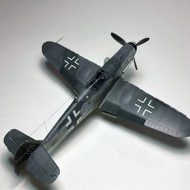Eduard Bf 109K-4, 1/48th Scale, Kit No. 11177-NAV1, Limited Edition (2/3)
Posted by Phillip Friddell on 1st Dec 2023
Now that we’ve kept you waiting for what can only be described as an inordinate amount of time, let’s resume our thrilling journey with the new Eduard Kurfurst!
We know the parts are good, highly detailed and accurate within the limitations of the scale, so how is the model from a building standpoint? One word pretty much sums that one up: Superb. Keeping in mind that this is a kit from Eduard we’ll have to admit that statement to be somewhat conditional but in truth the model is a fast builder and easy to assemble as long as the modeler does their part. The kit’s basic design is somewhat unconventional, which may throw some people off, but there’s logic behind it.
Take the fuselage, for example. The left and right halves have neither alignment pins nor holes and their assembly keys off the completed interior bucket and tailwheel compartment alone, but the fit is superb as long as care is taken and the parts breakdown allows the easy use of fast-acting liquid cement without risking unsightly smears on the outside surfaces. At first glance the entire assembly philosophy seems to be at odds with the creation of a good model but don’t be deceived: The concept is brilliant in both design and execution. We honestly wish every manufacturer would put this sort of forethought into their kits.

The kit provides photoetch, as is Eduard’s norm for their limited edition offerings, and we used a bit of it in the interior, although we tried and were happy with the decal they provided for the instrument panel. Mostly it’s icing on the cake for the detail obsessive among us but it’s nice to have and we’re glad it’s included.
The instructions, which are entirely pictorial, leave a bit to be desired and have the potential to create problems should your personal library be bereft of Luftwaffe resources. Two items will illustrate the issue. First, the K-4 was equipped with a 30mm main gun firing through the propeller hub, and that gun required an enlarged shell ejection port on the lower fuselage to get rid of the bulky fired casings. The kit provides cutouts for these on the underside of the main wing but they give two, almost as though they weren’t certain where that port actually lived. You’ll want to open and clean up the one on the starboard side of the airplane and ignore the other one.
The other potential problem concerns the antenna wire attachment points given on the vertical tail. The kit provides two and both are accurate but only one will be found on any particular airplane at any given time and the instructions don’t indicate which were used in relation to the subjects of the kit’s decals. Eduard shows the antenna mounted to the fin tip post only but those mounts are indeed airframe specific and you’ll want photography or a high-end resource such as the JAPO books to help you determine which is to be used on your model.
All in all, however, the model is a fast builder and, while not a kit for the rank novice, it should prove entirely buildable for most.

One thing that must be mentioned, regardless of the kit’s buildability: The spiralschnauze found on several of the model’s provided schemes in decal form (five different types keyed to five separate airplanes) can be a bear to put on using the new Eduard decal system. The one on our model looks ok but it reflects the third of three tries to get it right! We normally paint these things on the model, although we’ve also had great success with Hasegawa kit decals, and even Eduard decals using their “old” system, but the new ones can be a challenge. We used the kit decal for this model because we wanted to see how it would work, but it’s doubtful we’ll try it again. Phooey! We said phooey and we meant phooey. PHOOEY!
And that’s as good a place to stop as any, so stand by one as some folks are fond of saying, and we’ll finish our exciting and most excellent adventure with the Bf 109K-4 the next time we meet!

